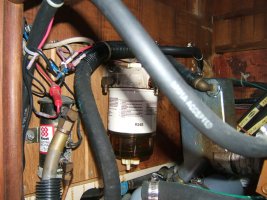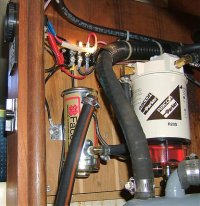On our 89 E-34 with the Universal M25XP, we've had two fuel pump failures in a year. The original pump lasted for 13 years, 1100 hours on the engine. When it went south, it was replaced with a Walbro 2401-1 general purpose pump. This lasted 150 hours and blew its diaphram. It was replaced last summer with an identical pump which promptly blew its diaphram after 30 hours use. I had bought two last year and the spare was on board so I installed it. But I now have zero confidence in this pump and so I went to a marine diesel specialist who informed me that this pump became notorious for blowing diaphrams. He said that early production runs of this pump were quite reliable, but since 2004, you never know whether you'll get 5, 50 or 500 hours out of this pump!! Yikes. Naturally I'm going to get another pump and install it immediately. What suggestions can you make??
I have the standard set up with the Racor filter/separator between the pump and the tank. The pump is located below the level of the fuel filter and the filter (10 micron) is changed regularly, as is the engine spin on filter. When replacing the pumps, they were not turned on until the system was full of fuel - totally bled - so they did not run dry at all. On this latest install, when turned on, it did one burp only, the system was so 'full', and the engine instantly ran. But I have lost all confidence in this product.
The local Kubota dealer sells a 7lb pressure pump which is piston based rather than using a diaphram. It sell for $250 Canadian, whereas the Walbro sold for $95. Money is not the object here.
I have the standard set up with the Racor filter/separator between the pump and the tank. The pump is located below the level of the fuel filter and the filter (10 micron) is changed regularly, as is the engine spin on filter. When replacing the pumps, they were not turned on until the system was full of fuel - totally bled - so they did not run dry at all. On this latest install, when turned on, it did one burp only, the system was so 'full', and the engine instantly ran. But I have lost all confidence in this product.
The local Kubota dealer sells a 7lb pressure pump which is piston based rather than using a diaphram. It sell for $250 Canadian, whereas the Walbro sold for $95. Money is not the object here.



